Distributed Systems
Indirect Communication
Indirect Communication
- indirect communication: communication between entities in a distributed system via an intermediary, with no direct coupling between the sender and the receiver/s
- Remote invocation is based on direct coupling between senders and receivers, making systems rigid and difficult to chane
- indirect communication used when change is anticipated: e.g. mobile environments with users coming and going
- disadvantages:
- performance overhead due to extra indirection
- more difficult to manage due to lack of space/time coupling
Space and Time Uncoupling
- space uncoupling: sender doesn’t know the identity of the receiver/s
- participants can be replaced, updated, replicated, migrated
- time uncoupling: sender and receiver don’t need to exist at the same time
- useful in volatile environments where participants come and go
- implies persistence in communication channel: messages must be stored
- NB different to asynchronous communication: asynchronous comms don’t imply that the receiver has an independent lifetime
| Time-coupled | Time-uncoupled | |
|---|---|---|
| Space coupling | message passing, remote invocation |
|
| Space uncoupling | IP multicast | Most indirect communication paradigms |
Paradigms
- group communication
- publish subscribe
- message queues
- shared memory
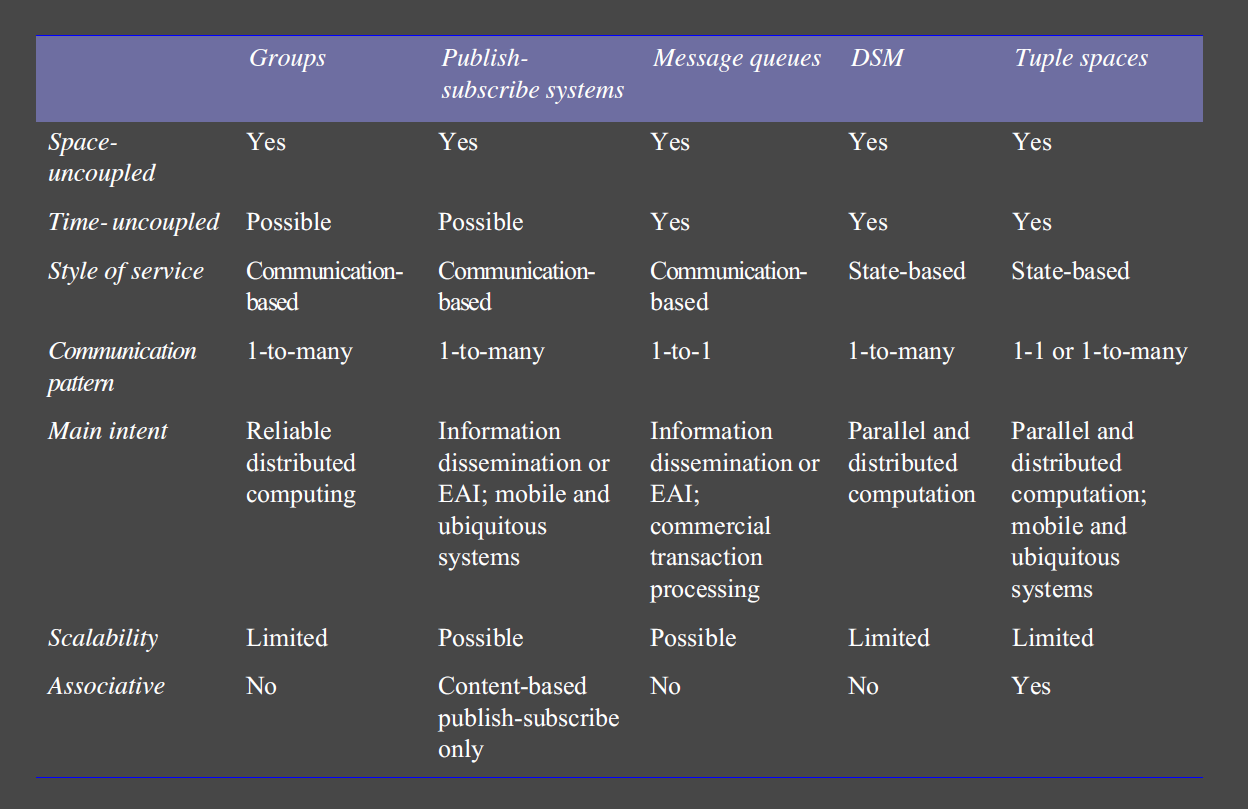
Group Communication
- group communication: communication via group abstraction
- space uncoupled service: sender doesn’t know receivers identities
- single message sent by sender to a group gets delivered to all group members
- single multicast send is defining feature c.f. multiple unicast sends
- management of group membership
- more effective use of bandwidth with single multicast to multiple receivers (instead of multiple, independent send operations)
- detection of failures
- reliability and ordering guarantees: if a process fails half-way through multiple independent send operations to different recipients, system has no way of guaranteeing whether all recipients received the message or not
- provides more than primitive IP multicast, but may be implemented over IP multicast or an overlay network
- important element when building reliable distributed systems
Applications
- financial: reliable dissemination of financial information (e.g. stock tickers) to large number of clients
- institutions need accurate, up-to-date access to large number of information sources
- multiuser game
- fault-tolerance: consistent update of replicated data
- system monitoring/management, load balancing
Primitives
- group
- group membership
- join
- leave
- multicast
- broadcast: communication to all processes in the system
Group Model
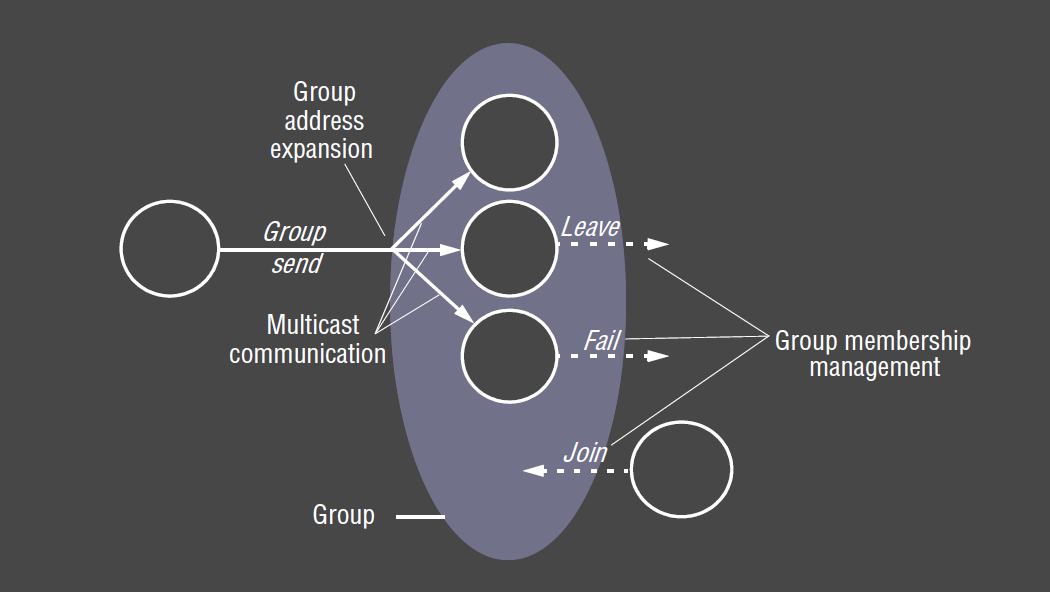
Group Distinctions
These distinctions signficantly impact the underlying multicast algorithms. e.g. some algorithms assume groups are closed
- process groups: groups where communicating entities are processes
- most commonly used, e.g. JGroups
- object groups: higher level approach than process groups
- collection of objects that process the same set of invocations concurrently, each returning responses
- closed: only members of the group can multicast to it
- open: processes outside the group may send to it
- overlapping: entities may be members of multiple groups

Implementation Issues
Reliability
- reliable multicast:
- integrity: deliver message correctly at most once
- validity: message sent is eventually delivered
- agreement: if the message is delivered to one process, it is delivered to all processes in the group
Ordering
- ordering is not guaranteed by underlying interprocess communication primitives
- Group services offer ordered multicast, which may possess 1+ of the following properties:
- FIFO ordering: preserve ordering from sender’s perspective
- if a process sends one message before another, it will be delivered in this order at all processes in the group
- Causal ordering: if a message happens before another message, this causal relationship will be preserved in delivery at all processes
- strengthening of FIFO: a message is not delivered to an application until all messages it depends on have been delivered
- Total ordering: if a message is delivered before another message at one process, the same order will be preserved at all processes
- all processes receive all messages in the same order
- doesn’t require causal or FIFO order, so not stronger than these orderings
- FIFO/Causal can be combined with Total if needed
FIFO ordering:

FIFO but not causal:
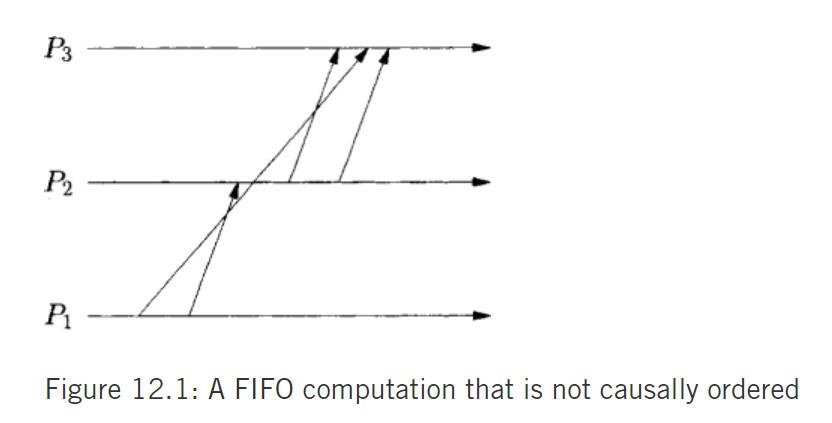
Causal Ordering:

Comparison of all 3:
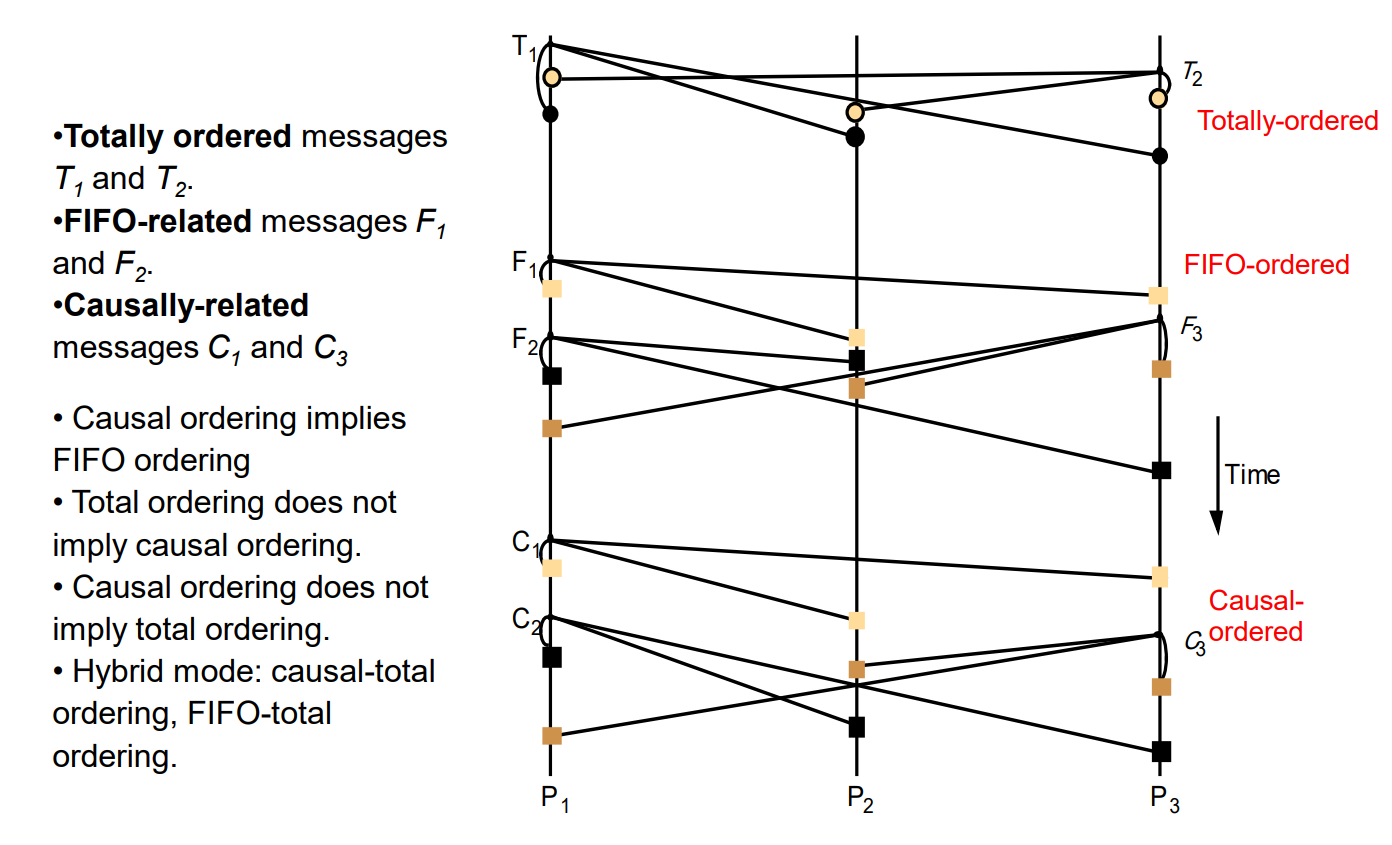
Group membership management
- group members leave and join
- failed members
- notify members of group membership changes
- changes to the group address
Unicast vs Multicast
- unicast: one sender sends message to one receiver
- UDP or TCP
- UDP: unreliable; packets may get lost, duplicated, arrive out of order, maximum packet size
- TCP: unicast, but handles retransmission, eliminates duplicates, fragments packets, presents messages to application layer in order
- multicast: one sender sends message to many receivers
- IP multicast extends UDP
- message transmission therefore unreliable
- no notion of membership
JGroups
- based on IP multicast: extends reliable unicast (1-1) message transmission (as in TCP) to multicast (1-many)
- JGroups: toolkit for reliable messaging
- can create clusters whose nodes can send messsages using group membership
- framework provides services to enable P2P communications between nodes in a cluster
Reliability
- lossless transmission of message to all recipients
- fragmentation
- FIFO ordering: messages m1 and m2 sent by P will be received by all receivers in the same order, not as m2, m1
- atomicity: message received by all receivers, or none
Group membership
- knowledge of members of group
- notifications when new member joins, existing member leaves, existing member has crashed
Features
- cluster creation and deletion
- joining/leaving clusters
- membership detection/notification
- detection, removal of crashed nodes
- point-to-multipoint: sending/receiving of node-to-cluster messages
Publish-Subscribe
- publish-subscribe systems: publisher disseminates events to multiple recipients via an intermediary
- aka distributed event-based systems
- most widely used paradigm
- publishers publish structure events to an event service
- subscribers express interest in events through subscriptions, which are arbitrary patterns over the structured events
- one-to-many: given event eventually delivered to many recipients
Applications
- financial information systems
- live feeds of real-time data
- cooperative working: number of participants notified of events of interest
- ubiquitous computing: management of events from ubiquitous infrastructure (e.g. location events)
- monitoring: e.g. network monitoring
- Google’s ad clicks
Dealing Room
- financial information system
- task: allows dealers to see latest market prices of stocks
- market price for a single stock represented by an object
- information providers: processes that collect information arriving in dealing room from a number of external sources
- each update is an event
- provider publishes events to pub-sub system for delivery to all dealers subscribed to the corresponding stock
- dealer process subscribes to a named stock
- it receives notifications and updates the objects representing the stocks
- update is then displayed to user
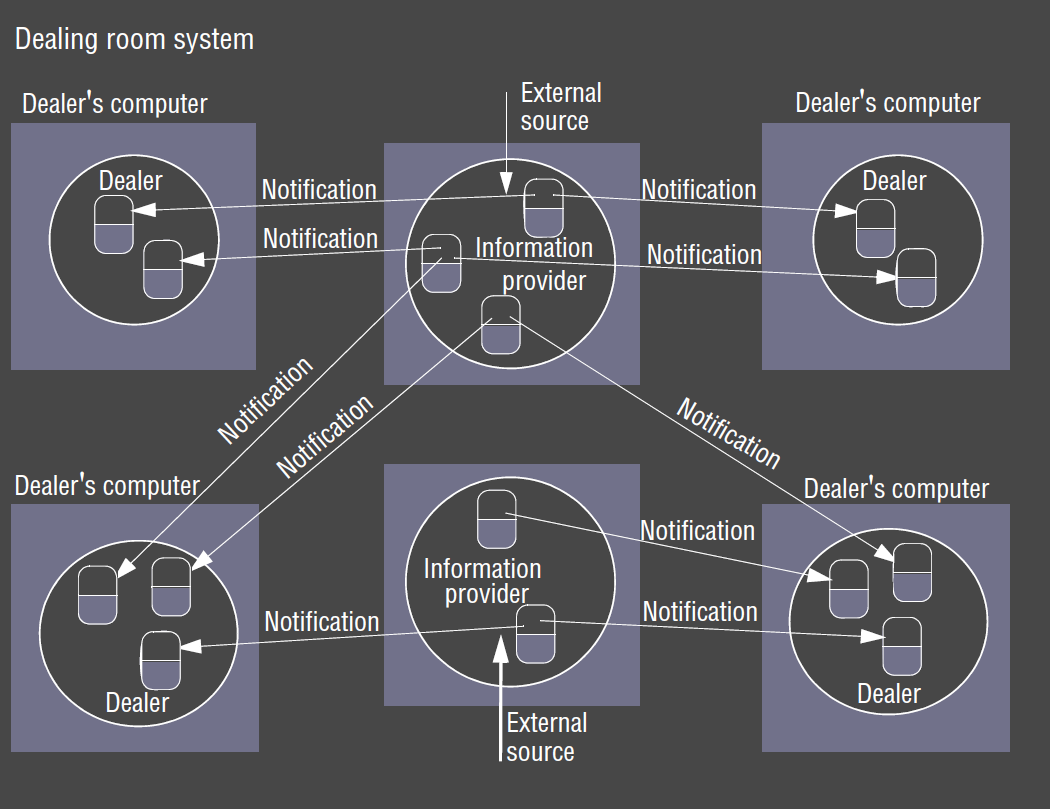
Events and Notifications
- RMI, RPC support synchronous communication model: client invoking call waits for results to be returned
- events and notifications are associated with asynchronous communication model
- event sources can generate different event types
- attributes contain event information
- types and attributes are used by subscribers when subscribing to events
- notifications occur when event types and attributes match that of a subscription
Characteristics
- heterogeneity: events allow components that weren’t designed for interoperation to work together
- publisher needs to publish required events
- subscribers need to subscribe to events of interest
- interface needs to be provided for receiving/dealing with notifications
- asynchronous: communication is asynchronous and event-driven
Model
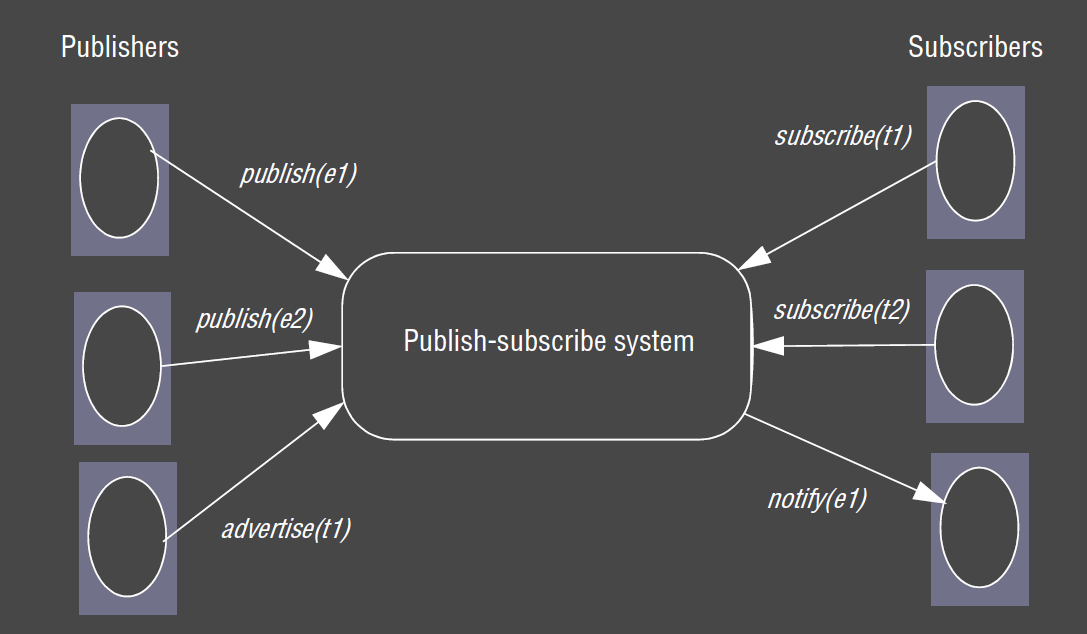
- event
e - filter
f publish(e)subscribe(f)unsubscribe(f)notify(e)advertise(f): publishers can declare the nature of future events in terms of filtersunadvertise(f)
Types
- channel-based: publishers publish events to named channels, and subscribers subscribe to one of these
channels to receive all events on that channel
- primitive: only scheme that defines a physical channel
- more advanced approaches use filtering over event contents
- topic-based/subject-based: notification expressed in terms of number of fields, one field denoting the topic
- subscriptions defined in terms of topics
- channels are implicitly defined, while topics are explicitly declared
- permits hierarchical organisation of topics
- content-based: generalisation of topic based approach
- express subscriptions over a particular values for a range of fields in an event notification
- notifications sent are those matching the attributes specified
- most flexible
- type-based: object-based, with objects having a specific type
- subscriptions defined in terms of types of events
- notifications sent are those matching types or subtypes of the given filter
- similar expressiveness to content-based
Implementation Issues
- basic requirement: ensure events are delivered efficiently to all subscribers with filters matching the event
- additional requirements: security, scalability, failure handling, concurrency, QoS
- increases complexity of iplementation
Centralised vs Decentralised
- centralised: server on a single node acts as an event broker
- publishers publish events to broker
- subscribers send subscriptions to broker, and receive notifications in turn
- interaction with broker is through point-to-point messages: message passing or remote invocation
- advantages: simple to implement
- disadvantages: lacks resilience and scalability as server is a single point of failure and a performance bottleneck
- distributed pub-sub: network of brokers cooperate to provide desired functionality
- improved ability to survive node failure
- proven to operate well in Internet-scale deployments
- P2P pub-sub: no distinction between publishers, subscribers, and brokers
- all nodes act as brokers, cooperating to provide required event routing functionality
- very popular for recent systems
Network of Brokers:
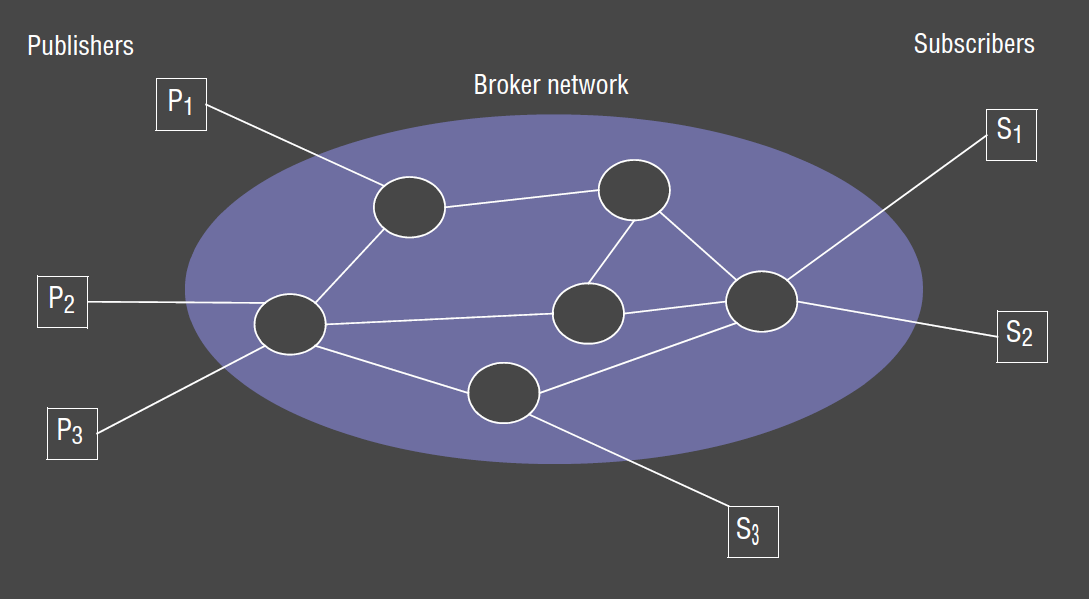
Overall Architecture
Range of choices for architecture

- event routing: ensures event notifications are routed efficiently to appropriate subscribers
- overlay networks: supports event routing by setting up networks of brokers/P2P structures required
- top layer: implements matching of events to a subscription, often a part of event routing layer
Content-based Routing
- flooding: send event notification to all nodes in the network, then carry out matching at subscriber end
- can also send subscriptions to all publishers, with matching carried out by publishers
- implemented with underlying broadcast/multicast
- brokers can be arranged in an acyclic graph, forming an multicast overlay network where each broker forwards incoming notifications to all neighbours
- simple, but produces lots of network traffic
- filtering: apply filtering in network of brokers
- brokers forward notifications through the network only where there is a path to a valid subscriber
- each node maintains
- neighbours list of all connected neighbours in the network of brokers
- subscription list of all directly connected subscribers this node services
- routing table with neighbours and valid subscriptions on that path
- can generate lots of traffic to propagate subscriptions (which are basically flooded)
- advertisements: propagates advertisements towards subscribers
- gossip: nodes in the network periodically and probabilistically exchange events with neighbours
- mechanism for achieving multicast
- informed gossip takes into account local info and content
Examples

Message Queue
- message queue: messages are placed on a message queue, receiver extracts messages from the queue
- message queue is an indirection
- provides space and time-uncoupling through storage of messages
- messages are persistent: messages are stored until consumed
- point-to-point: sender places message in the queue, which is removed by a single process
- groups, pub-sub are one-to-many, MQ is point-to-point
- line often gets blurred between MQ and pub-sub: pure pub-sub shouldn’t record anything
-
basis of commercial transaction processing systems: natural fit for transactions
- centralised/decentralised: key implementation issues
- centralised: simple, performance bottleneck and single point of failure

Programming Model
send: producer puts message on a particular queuereceive(blocking): consumer waits for 1+ message on a queue before returningpoll(non-blocking): consumer checks if queue has a message, returning it if present, otherwise returns without a messagenotify: generates an event at the receiver when a message is available
Example

Shared Memory
- distributed shared memory operates at level of reading/writing bytes
- memory accessed by address
- tuple spaces offer higher-level perspective: semi-structured data
- accessed by pattern-matching on content
Distributed Shared Memory
- distributed shared memory (DSM): abstraction of global shared memory between computers that don’t share physical memory
- processes access DSM by reads and updates to what appears as normal memory in their address space
- used in HPC and distributed system; quite specialised
- spares programmer having to worry about message passing
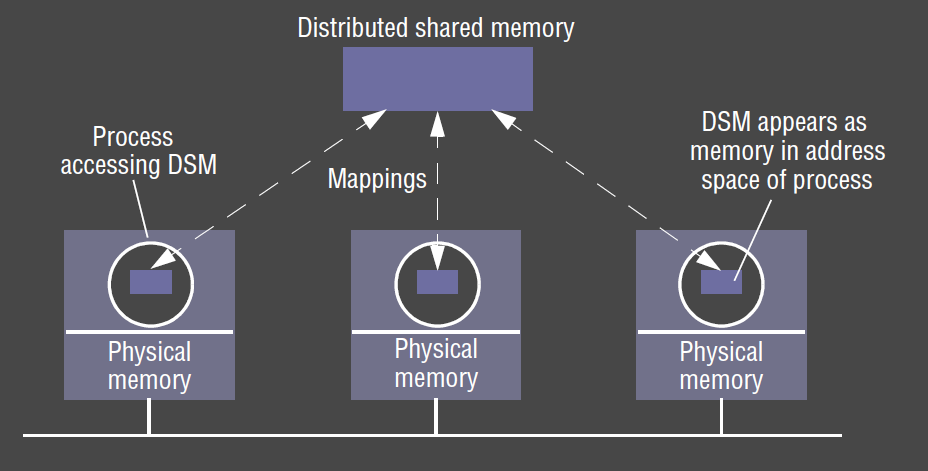
Tuple Spaces
- processes communicate indirectly by placing tuples in a tuple space, from which other processes can read or remove them
- tuples are accessed by pattern matching on content
- tuple space is a repository
- process can add, withdraw, read tuples by atomic operations
- tuples can contain different values
- processes can inspect context via pattern matching
- compared to message passing, tuple spaces are a higher level of abstraction
- main challenges:
- best data structure for distributed multiset of tuples
- efficient tuple processing and data distribution
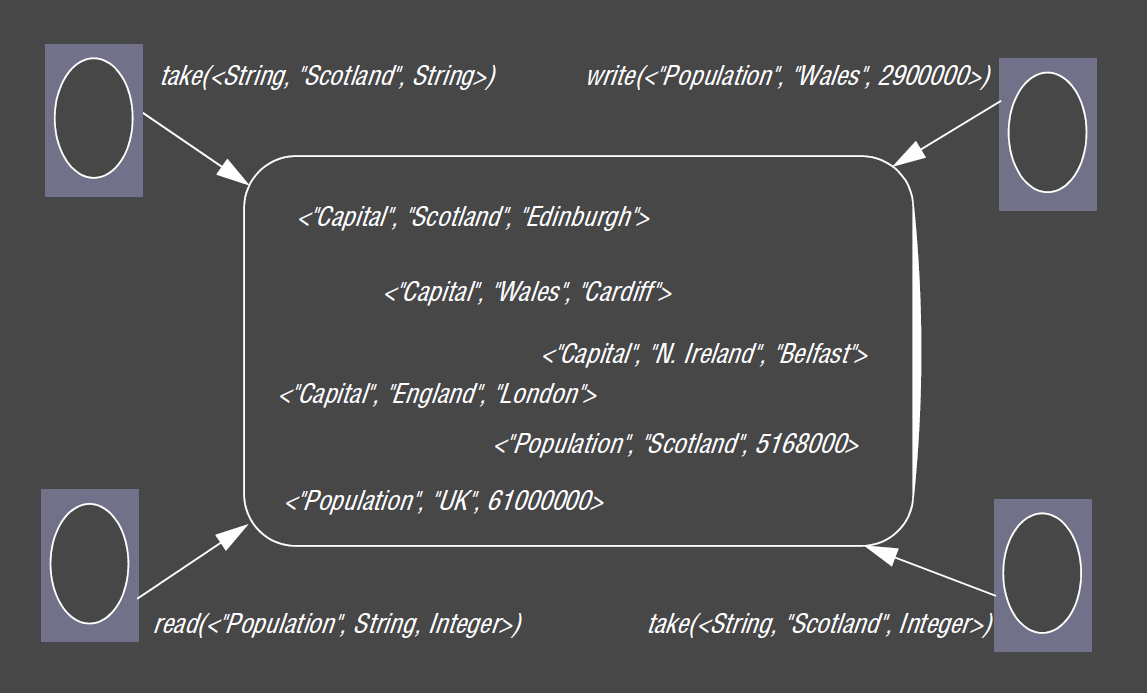
York Linda Kernel

- TSS = tuple space server
- complexity in communication
- scales poorly: difficulty in guaranteeing consistency across tuple spaces
JavaSpaces
- JavaSpaces: high-level tool for building distributed/collaborative applications
- one of the first implementations of tuple spaces, by Sun Microsystems
- based on Java’s Jini and RMI
- tuples are instances of Java classes, fields are public attributes of the class
- tuples are restricted to containing objects and not primitive values
- tuple space is a Java collection
- pattern matching is performed at the byte-level, supporting OO polymorphism
- provides a shared space for object storage and exchange
- uses a simple but expressive API
- objects are stored in JavaSpaces as serialised object entries
- entries are typed: templates for one type won’t match a different type
- API
writeentries into the spacereadentries from the space (leaving it in the space)- you get a random entry that matches your template
- if there are multiple matches, you only get one
- to remove all, you use a loop
takeentries from space (removing it from the space)notifysends notification through an event handler if entries matching a template are added- aditional:
eval: spawns new processes, allows code mobility
- template: entry with 1+ fields set to null
- matching: entry matches a template if
- same type/subtype
- every non-null field matches exactly
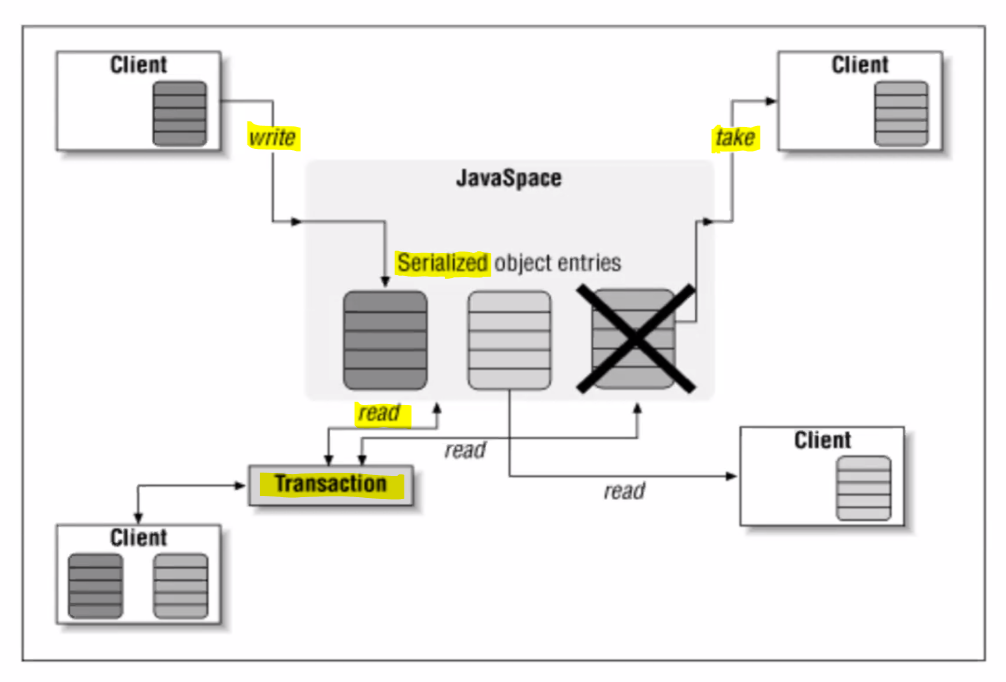
Design Goals
- platform to simplify design and implementation of distributed systems
- client should have few classes to maintain simplicity and reduce download time
- client should have small footprint so it is able to run on computers with minimal memory
- support variety of implementations
- replication should be possible
JavaSpaces vs Databases
- not relational database
- relational database:
- based on relational model of data, storing data in structure format using rows/columns
- understand data stored
- manipulated via SQL
- JavaSpaces:
- store entries they understand only by type and serialised form of each field
- no general queries in JavaSpaces, only “exact match” or “don’t care”
- relational database:
- not object database
- object database: DBMS in which information represented in form of objects
- OO image of stored data that can be used/modified similar to the object being in primary memory
- JavaSpaces:
- do not provide nearly transparent, persistent, or transient layer
- works only on copies of entries
- object database: DBMS in which information represented in form of objects